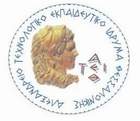Description of the Room
The Tele-education Room of Thessaloniki's ATEI has a capacity of 50 seats and supports synchronous and asynchronous tele-education as well as teleconference with multipoint connections of up to eight points.
Types of tele-education that are supported by the Tele-education facility of Thessaloniki's ATEI
Where can tele-education be used?
Equipment
Types of tele-education that are supported by the Tele-education facility of Thessaloniki's ATEI
Synchronous tele-education provides the same and even more facilities than a regular room. The synchronous tele-education's advantage is that the teachers and the students can be in different places each one, and by using tele-education facilities they can all be in a virtual classroom.
Asynchronous tele-education is a type of education that can be provided in different/other time and different place for each participant. The teacher has the ability to upload the electronic educational material and the students have the ability to work with the educational material at any place and any time having the ability of asynchronous communication with the other participants.
Tele-education is used in order to improve the communication between the members of the Academic community and their colleagues, who work outside the educational institute, in research, teaching and administration level.
Where can tele-education be used?
People have the impression that tele-education technologies can be used only in the academic world, for educational purposes. By the use of tele-education students save precious time for moving and have the option to chose the ammount of time they will spare.
All the above parametrs make tele-education appealing also to the business community. Employees can attend seminars, continue their education without having to waste time for moving and without being absent from their work. Enterprises are very interested in such technologies since they offer the opportunity for continuous education of their employees with small cost.
Equipment
- Tele-education System VCON MONITOR 3000 VDK
- In this computer the teleconference card Monitor3000 is installed, running in Win XP Pro. The card has the ability of teleconference either via ISDN (Η.320 έως 384Kbps) or via internet TCP-IP (Η.323)
- We handle the card with the program VCON Meeting Point v4.6
- Microphonic Facility
- It is digital, so it can be connected to a computer and be handled by software. It consists of:
- One Chairman microphone Philips-Bosch 3533/00,
- Twenty three Audience microphones Philips-Bosch 3530/00,
- Central Microphonic Control Unit - Philips-Bosch CCU 3500/15,
- Two Wireless microphones Sennheiser EW 135
- Mix Sound Amplifier Philips - Bosch 19/12/00, και
- Six wall mounted speakers Philips - Bosch 3935/00.
- Server computer with MCU software, which
- On this computer which runs Win XP Pro, the administration software of teleconference terminal ΜΧΜ and software MCU (Multipoint Control Unit) VCON VCB is installed.
- On ΜΧΜ we have the ability to register up to 20 terminals but only 10 can be active and with VCB, multipoint conference control unit, we can host a multipoint conference with up to eight remote points.
- This computer is connected via serial port RS-232 to DCN for control of the microphones and dome camera.
- Camera PTZ - Philips - Bosch G3ATS5C
- The camera has the capability of 360o rotation and vertical slope from 0o to 90o.
- The camera's lens has optical Zoom 25Χ and digital Zoom 12Χ.
- The camera can be controlled with two ways: (α) manually by the camera's control PTZ Philips - Bosch 5136/50 and (b) automatically, so that each time it shows the current speaker.
- Network Camera - Philips - Bosch LTC 0204/11
- The network camera is autonomous and combines high resolution coloured picture, video compression, motion tracing and video recording.
- Net cam 4 has inputs for three (3) simple analog colour cameras.
- It works as a server for these cameras and can send images either all together in the form of four windows, or solely.
- In reality it is a complete PC with memory, 6GB hard disk and Linux software (for embedded systems). It supports various communication protocols and is compatible with 10 Base-T Ethernet .
- Switcher of video and sound - Extron 42 HVA
- The video and sound switcher (Video Matrix Mixer) is an analog data, video and sound switcher with 4 inputs and 2 outputs. Every input is independent and can be visualized by any independent output. Moreover, Video Matrix Mixer can be connected to a computer via port RS-232 so that the system's function can be controlled by a software.
- LCD Projector - Lumens LM 136
- It can project two (2) pictures at the same time in Picture In Picture and Picture By Picture form, i.e. it has the ability to present two inputs into two different windows concurrently.
- Electronic Blackboard - ΜΙΜΙΟ ΧΙ
- It gives us the ability to record and transfer to a PC everything we write on the blackboard with the marker, so that it can be transfered in real time to the distant students who attend via teleconference.
- It has the ability to tranfer notes so that they can be used in other applications for PCs (e.g. Microsoft Word, Microsoft PowerPoint etc.).
- Video Data Presenter - Lumens PS 500
- It gives us the ability, thanks to its built-in camera, to present coloured pictures, three dimensional objects, images from microscopes and slides, which we can also transfer via a PC to the students.
- Projection Screen - Stumpfl BIM-PQ200
- The projection screen has dimensions 200 x 200 cm., it weighs 12,8 kg, and it is white.
- Two Philips VR-530 videos and a DVD Player Pioneer DV-464
- For presentation of material written on a DVD or tape and for video tape recording of lectures that will take place in the room.

